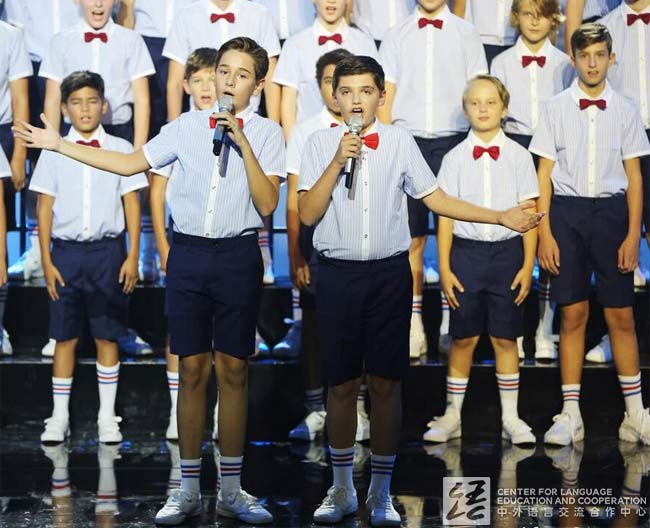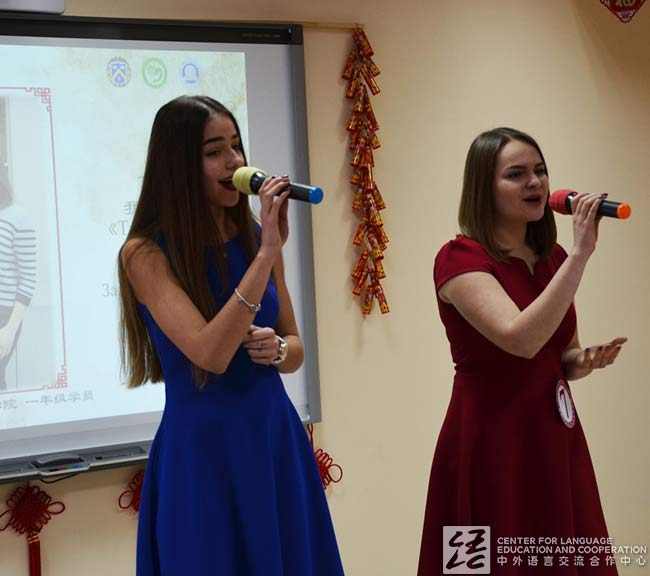"Sing & Learn Chinese."^——Teaching Secrets of International Chinese Language Teachers
Information Sources:People's Daily Overseas Edition
In the past years, a lot of foreign students have chosen to sing Chinese songs in the talent show of the "Chinese Bridge" Chinese Proficiency Competition for Foreign Secondary School Students. This shows that Chinese songs are very popular among Chinese language learners. There is no boundary for music and music is a universal language. Chinese music not only contains traditional Chinese culture, but also has a dynamic rhythm that can easily engage students' interest. Chinese music is a potential resource for international Chinese language teaching. As international Chinese language teachers, we have tried to use teaching how to sing Chinese songs to supplement our Chinese language teaching, and we have received better effects and positive comments.

As for the "Chinese Bridge" Chinese Proficiency Competitions, singing is one of common ways to show talents.
First, learning to sing Chinese songs assists in phonics teaching. As for elementary Chinese language textbooks, phonics teaching is the priority. In particular, the pronunciation of the vowel "u" in certain compound vowels is a common difficult point for many students. If you catch students' pronunciation errors in teaching and keep correcting them, it is easy for students to become frustrated and become emotionally anxious, which affects their motivation to learn Chinese and the effectiveness of class teaching.
How can we resolve the conflict between "the need to clarify phonics in the early stages of teaching" and "the pressure to frustrate students by forcing them to correct phonics mistakes"? We will solve this problem by playing and learning to sing the children's song "Xiǎo mìfēng (Little Bee)".
Xiǎo mìfēng (Little bees)/fēi dào xī yòu fēi dào dōng (fly to the west and east)/wēng wēng wēng wēng (buzzing buzzing buzzing)/wēng wēng wēng wēng (buzzing buzzing buzzing)/ bùpà yǔ yě bùpà fēng (not afraid of rain or wind.)/

Ukrainian students are participating in the competition entitled "I Sing Chinese Songs"
The lyrics of this song are simple and contain the rhyme "ueng", which is the focus of teaching, and it is repeated very frequently. We paused the song at the line "嗡嗡嗡嗡(wēng wēng wēng wēng)" and let the students take turns singing it, and we joined them in singing along a few times so that they could imitate it better.
Through this repeated practice, when we returned to the rhyme "ueng" on the blackboard, we found that the students' pronunciation improved significantly. Moreover, throughout the learning process, the students said that the song was interesting and motivated their interest in learning Chinese by learning to sing Chinese songs.
Second, learning to sing Chinese songs is helpful to grammar teaching. We can also use Chinese songs to assist in teaching grammar. For example, some textbooks have sentences like "Tā gāo gāo de gèzi, hēi hēi de tóufǎ, dàdà de yǎnjīng, zhēn piàoliang (She is tall, with black hair and big eyes. She is so beautiful.)". In order to deepen students' understanding of this grammar point and its application, we chose the Chinese song Wān wān de yuèliàng (Crescent Moon) to help to teach students.
This song was chosen because the adjective "Wān wān de" appears very frequently in this song, and the song is slow in pace, beautiful in melody and simple in words, so students have less difficulty in listening and understanding it.
While teaching it, we started by playing a verse from the song. After listening, the students said it sounded good. Then we projected the pinyin-labeled lyrics on the board with PPT and translated the lyrics for them sentence by sentence. We marked the meaning of "Wān" in English, and then marked the meanings of main nouns such as "yuèliàng", "Xiǎochuán" and "Xiǎoqiáo" in English, to make students identify their meanings.
After students were familiar with the song, we had three students come to the podium and draw pictures on the board based on the lyrics they heard. After the drawing, we let them put a few pictures that match the content and artistic conception of the lyrics, and asked the students with gestures, Does the "Wān wān de yuèliàng" mean that the moon is particularly crooked? Does the "Wān wān de Xiǎoqiáo" mean that the bridge arches particularly high? Then we guided students to pay attention to the example sentence "Hóng hóng de píngguǒ" in their textbook. Does it mean that the apple is particularly red? In this way, the part that is most likely to misunderstand in this language is cleared off.
Third, learning to sing Chinese songs is conducive to vocabulary teaching. One text is "Wǒ ài wǒ de jiā (I Love My Home)" and the theme is about family. There is "Bàba (dad)", "Māmā (mom)", " Dìdì (younger brother)" and " Mèimei (younger sister)" in the text, therefore basing on the students' Chinese level and actual family situation, we chose the song " Ràng ài zhù wǒjiā (Let Love Stay in My Home)" to support the teaching of vocabulary.

Teachers and students from the School of Education, University of Dar es Salaam, are singing Jasmine together
The lyrics of the song "Let Love Stay in My Home" are simple, slow and heartwarming, which fits well with the theme of this lesson. At the same time, the characters "Bàba (dad)", "Māmā (mom)", "Érzi (son)" and "Nǚ'ér (daughter)" in the lyrics are all that have been learned in the text. Moreover, the singers can choose different roles to sing different lyrics, for example, female students can sing "Wǒ ài wǒ de jiā, dìdì, bàba, māmā. (I love my family, my younger brother, my father, my mother)". The lyrical structure is ideal for practicing new words.
Once everyone had listened a few times, we erased the lyrics and had the students fill in the lyrics based on their roles. Finally, while playing the song, we asked students to write sentences to introduce their family members by imitating the structure of the lyrics. In this way, we used a song to smoothly link up the lecture and practice sessions of the vocabulary.
A song called "Xiǎo mìfēng (Little Bee)" solved students' pronunciation problems, a song called "Wān wān de yuèliàng (Crescent Moon)" taught students to use Chinese reduplicated words, and a song called "Wǒ ài wǒ de jiā (I Love My Home)" linked up the vocabulary practice sessions. Through the above examples, we can see that the use of Chinese songs to supplement teaching can sometimes yield twice the result with half the effort.
The role of Chinese songs in Chinese language teaching should not be overlooked, but there are shortcomings. For example, there are songs that contain instructional objectives, but the parts except the instructional objectives are well beyond the current instructional pace in terms of grammar or vocabulary. Therefore, when applying Chinese songs to classroom teaching, international Chinese teachers should choose songs that are in line with modern Chinese norms, pedagogically relevant, meanwhile meeting students' interests and motivating them to learn.
Authors: Li Qingqian & Meng Dehong

